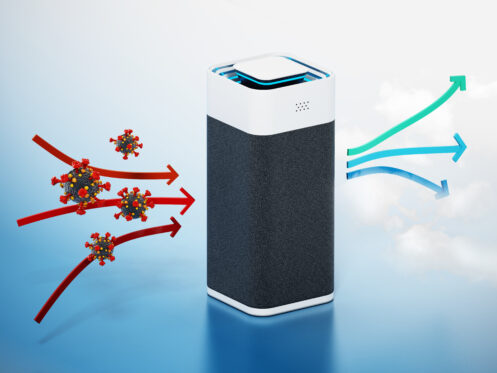If you have one or more pets living in your Cheshire, CT home, your indoor air quality (IAQ) is probably a constant concern. This is truer if you or any other members of your household suffer from allergies, asthma, or another chronic respiratory issue. The good news is that you don’t have to part ways with your canine or feline companion to breathe easy. With the right IAQ measures, you can eliminate the fur, dander, dust mites, and other allergens that are making your life miserable. The following are 10 ways to get started.
1. Know the Real Culprit
It’s easy to blame your sniffling, sneezing, and watery eyes on visible accumulations of pet hair. However, most pet allergies aren’t actually triggered by pet hair. Instead, allergies are the result of a special protein that’s found in dog and cat saliva, urine, and dander.
Classified as an IgE-binding protein, this protein handily ranks among the top two pet-related allergens. The other is dander. Dander is the dead skin that mammals constantly shed throughout the day. Although dander can wreak havoc on your IAQ on its own, it’s the saliva that coats it that really agitates allergy sufferers. When animals lick themselves as part of their grooming routines, large amounts of this protein are transferred onto their skin. Thus, when structuring your IAQ improvement plan, one of your top goals should be limiting how much of this protein you’re encountering.
2. Upgrade Your Vacuum
You can use your vacuum to pick up a fair amount of pet hair and loose dander. People who have pets and pet allergies often get the best results from vacuum cleaners with high-efficiency particulate air (HEPA) filters. An anti-allergy vacuum with a true HEPA filter can pick up as much as 99% of the dry, pet-related allergens that are trapped in your carpeting, your drapes, and your upholstered furnishings. You should also opt for a model with a bag-free design so that your vacuum isn’t releasing dust from one end while picking it up from the other.
3. Consider Installing a Whole-House Humidifier
With protein-carrying dander as your number one target, you may need a little help moistening your indoor air. Although a vacuum with a true HEPA filter will collect the dander that has already settled on surfaces, it won’t do anything for the airborne particulates that constantly float throughout your air. The dander itself is both lightweight and dry. In dry air, it can remain airborne for two hours or more. Having a humidifier add a small amount of moisture to your living environment will weigh these particulates down so that they’re eventually captured by your vacuum.
4. Groom Your Pets Often and Outside
Diligently grooming your pets will remove loose hairs and dander before it gets scratched or licked free by pets themselves. Grooming your pets outside ensures that these allergens aren’t added to your home.
5. Adjust Your Schedule for HVAC Air Filter Changes
For pet-free and allergy-free homes, the recommended schedule for HVAC air filter changes is once every one to three months. Homeowners should inspect these components every 30 days, but if light continues to shine through them, they’re still considered viable. In your home, you might want to check your HVAC air filter every 14 to 30 days. Moreover, you should probably change it every 30 to 45 days.
6. Invest in an Air Filter With a Higher MERV Rating
All HVAC air filters in the United States are assigned a maximum efficiency reporting value or MERV rating. Standard air filters have a MERV rating of 8 which is considered sufficient for protecting HVAC equipment. Although modest IAQ benefits are provided by standard filters, this isn’t the primary purpose of these components.
In your home, you might need air filters with MERV ratings of 11 or higher. These filters are designed to pick up airborne contaminants that are smaller than .3 microns. They extract the micro-fine dust particles and dander that move right through many standard filters to create cleaner, healthier indoor air.
7. Consider the Benefits of Whole-House Air Purification
Integrated IAQ accessories are either installed directly in HVAC ductwork or attached to it. These units support and enhance the filtration provided HVAC systems. Among some of the most popular options in IAQ accessories are:
- Air scrubbers
- Air purifiers
- Media Filters
Both air purifiers and media filters offer multi-stage filtration. Some options contain true HEPA filters and use fans that constantly draw air in from the home, extract common pollutants, and then cycle it back indoors. Air scrubbers offer both multi-stage filtration and the additional benefit of sanitization. After filtering air, they release sanitizing agents into homes that gently “scrub” the indoor air.
8. Increase Your Home’s Mechanical Ventilation
You might be surprised to discover that your home can “breathe”. In a process known as induction, buildings draw fresh, outdoor air in while expelling stale, stagnant air through the cracks and gaps in their materials. Unfortunately, this process is increasingly inhibited by widespread efforts to tighten home envelopes.
For the sake of efficiency, homeowners are encouraged to seal up air leaks around their windows and doors, add or improve insulation, and take other measures to limit or prevent energy loss. As the ability of homes to “breathe” via induction gradually declines, the “V” in HVAC becomes ever more important. Ventilation is easily the most overlooked aspect of home climate control and indoor air quality improvement.
Even if you can’t stop your cat from “marking” the carpeting in a favorite corner or the upholstery at the base of your living room chair, you can control how much of the allergy-inducing, IgE-binding protein you’re being exposed to. While most modern homes are built with good mechanical ventilation, yours may not be sufficient for your household. Having your mechanical ventilation inspected and upgraded is a great way to clear this protein out via dander removal. In the meantime, periodically turn your HVAC system off and open a few windows and doors.
9. Keep Your HVAC Air Vents Free of Pets and Pet Items
You might have a dog or cat that loves getting the first blast of conditioned air when your HVAC system is turned on. However, it’s generally best to keep pets away from all HVAC air vents, grilles, and registers. Outgoing air could blow through your pet’s coat and pick up allergens along the way. You should also keep all litter boxes, puppy pads, play structures, and pet beds far away from these features as well.
10. Wash your Linens and Bedding Often
Wash your bedding often and try to keep your pet from curling up in it. It’s also a good idea to regularly wash rugs, blankets, and all other soft, porous items that your pet frequently snuggles up with. This will limit the presence of dander and dust mites.
We work hard to help residents of Cheshire, CT breathe easier. We offer air conditioning, heating, plumbing, and energy conservation services. We also provide advanced IAQ solutions. To learn more tips on indoor air quality, read here! If you have a pet and need help improving your indoor air quality, contact F.F. Hitchcock Plumbing, Heating & Cooling now.







